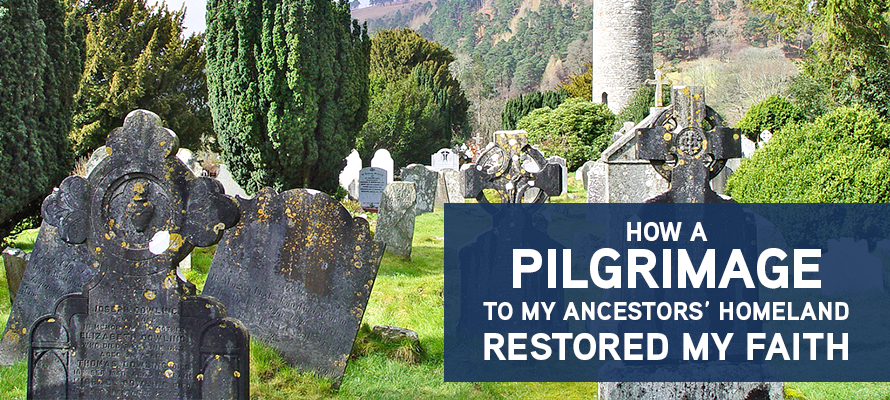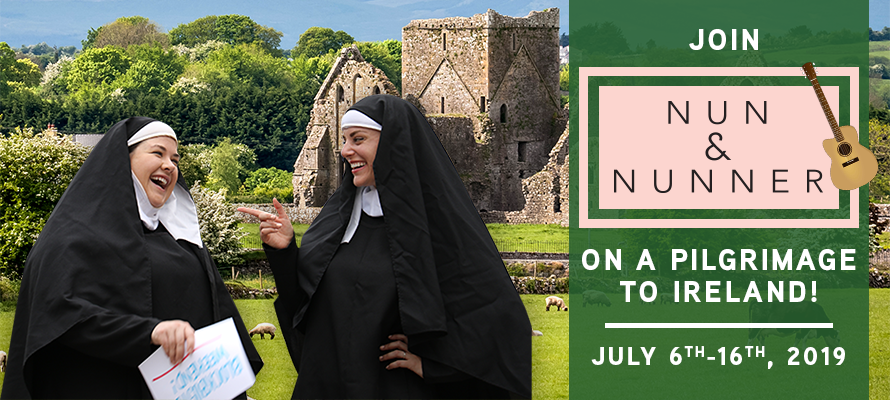
My adult faith had never been lower than the first time I set my big, wide Irish feet on actual Irish soil. My beloved grandmother had passed away a few months before the trip. I’d inherited her rosary, the one on which each bead represented to her one member of her family of nine children and her many grandchildren through them. Shortly after her death, I’d left a job in ministry, feeling like an utter failure. My health was shaky on several fronts. I was facing family strife of all sorts. It seemed every prayer I’d made had been going unanswered, to the point that I couldn’t even bring myself to pray anymore. I had prayed Granny’s rosary daily for a while, but then praying it just became too hard. I hadn’t even packed it for this trip.
I wasn’t even on a proper pilgrimage. It was just a secular vacation. We did make a stop at the Shrine of Our Lady of Knock, but mostly our stops on that trip included places like the Guinness Brewery, the Waterford Crystal factory, and Bunratty Castle. Traveling with a family member who was into genealogy, however, we also found ourselves in churchyards, looking at gravestones going back to the 1800s, many of them with my relatively uncommon Irish maiden name chiseled into their fading faces.
At first, I thought it was puzzling, seeing one gothic revival church after another, like Galway Cathedral and even the little village churches where several generations of my distant relatives lay buried. I don’t know when it sunk in, however, that the reason most of the churches were in the gothic revival style was because that was the architecture in vogue at the time that the Irish people after long centuries had at last won back their right to worship in the Catholic faith. Perhaps it was a visit to my grandfather’s family town of Enniscorthy, County Wexford, where memory of the 1798 Rebellion still pulses strong, and the locals will yet tell of Father Michael Murphy, who defended his people and his Lord in the Blessed Sacrament to the very faces of the soldiers sent to suppress him and all his people, even unto his own death. Maybe it was hearing a priest in my other grandfather’s ancestral village explain that baptismal records for the people of Ireland only go back so far, because they were all burned by their conquerors, hostile to the faith.
Such was the early 19th century, the great Irish diaspora. Just as some of my ancestors were scraping together their meager earnings to rebuild their Church, some others, the ones from which I am directly descended, were leaving behind all they had, sailing for America and an unknown future. They left behind stony fields and low mountains and poor turf fires for nothing but hope. How could I not be inspired by their example?
If the Irish Catholic history of conquest and rebirth hadn’t reached me, the power of Ireland’s natural landscape would have. Not only had I received the faith so many died to keep alive for me, I’d also brought my German, then-agnostic husband along on that first trip, and that was where he says he first felt God reach into his heart. A few years later, telling his own conversion story, he quoted one of our bed and breakfast hosts, himself an Englishman who had emigrated to Tralee and, it seemed, been conquered by Ireland itself: “In these places, God just feels closer.”
We had tried to leave God and Mother Mary behind us in the States. It seemed they had followed us to Ireland—rather, had been waiting for us there the whole time.
When we feel our faith is shaken, there is one thing of which we can be sure: wherever there is or was Catholicism, there was or is persecution. The perseverance of prior generations can help us not just appreciate the blessings they fought to give us but can inspire us to persevere in their footsteps. Another way to revive flagging faith is to look to our ancestors, not just for their example but for their personal investment in seeing us, their children’s children, make it to heaven. We can call upon our them for their intercession. If you don’t have it in you right now to pray for yourself, chances are that at least one person in your family tree is in a place to pray for you, even if you’re descended from an actual rogue’s gallery. Best of all, consider a pilgrimage to your ancestors’ homeland. There are abundant graces to be had walking the earth they walked and worshipping in the churches their hands built.
That was our first trip to Ireland. My husband went home, newly awake to the movement of God in his life. I went home, inspired by the courage of my ancestors. Like the Hebrews Paul had admonished, for all my troubles, I certainly had not struggled against sin to the point of shedding blood (Hebrews 12:4), but my ancestors had. Those who had survived left everything behind to bring the flame of faith to a new land, not knowing if they or their faith would survive there to rise up still in future generations. Their hope did not disappoint.
More recently, I returned to Ireland, this time on an intentional pilgrimage with my husband and children. Once again, I had to leave Granny’s rosary behind, but this time with good reason: it now rests in a special spot in my jewelry box, long since fallen to pieces from much use.
Erin McCole Cupp is a wife, mom and lay Dominican from the rough edges of Philadelphia. She is a Pilgrim at heart, always journeying closer to Christ and the Catholic faith. She is currently at work on a book for Our Sunday Visitor on spiritual growth for the wounded parent.




